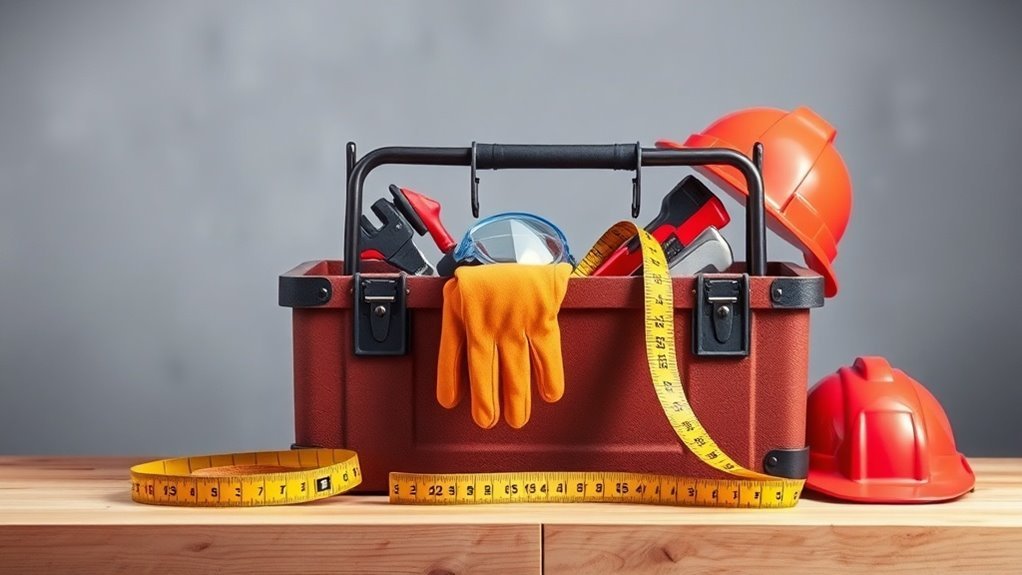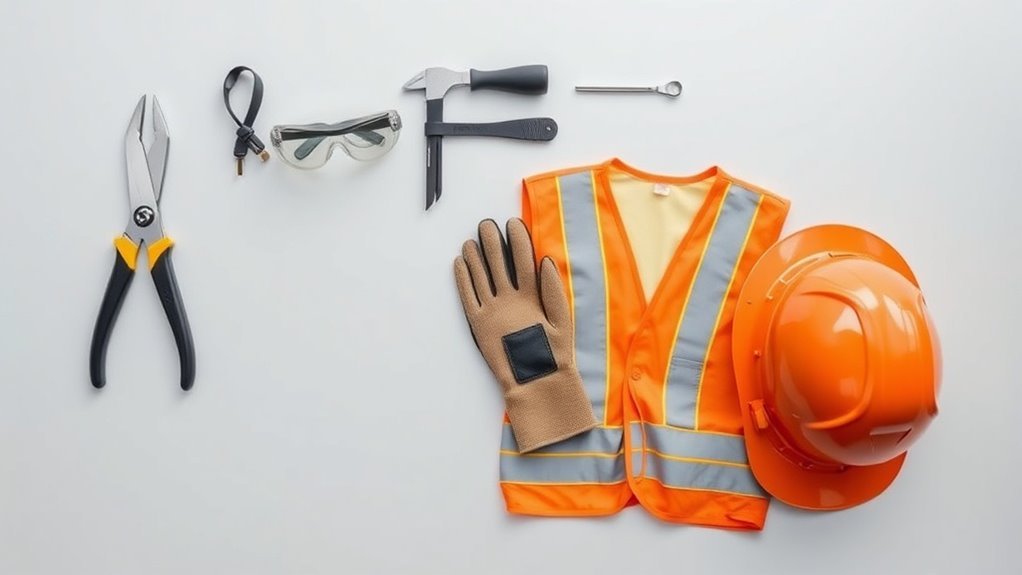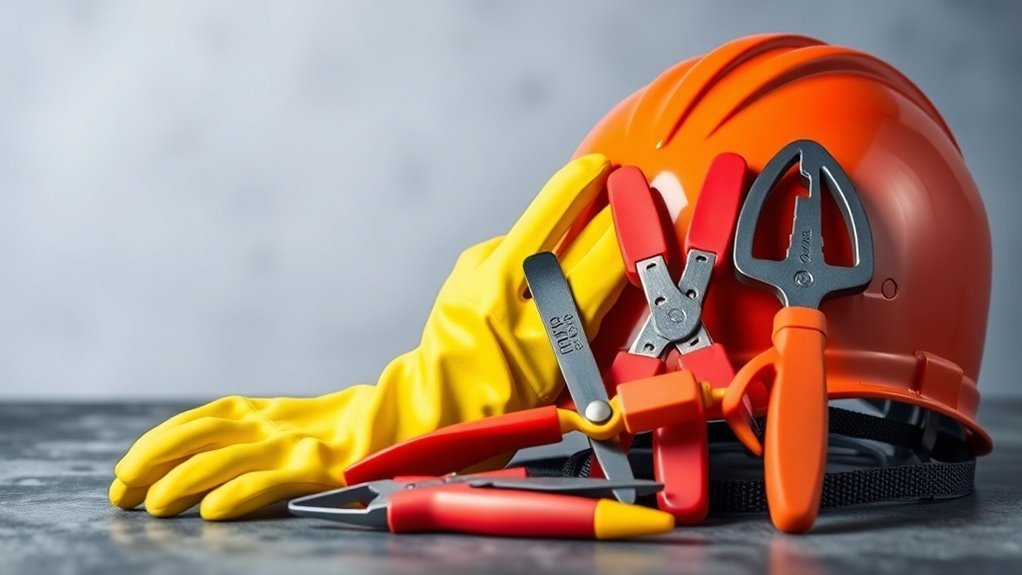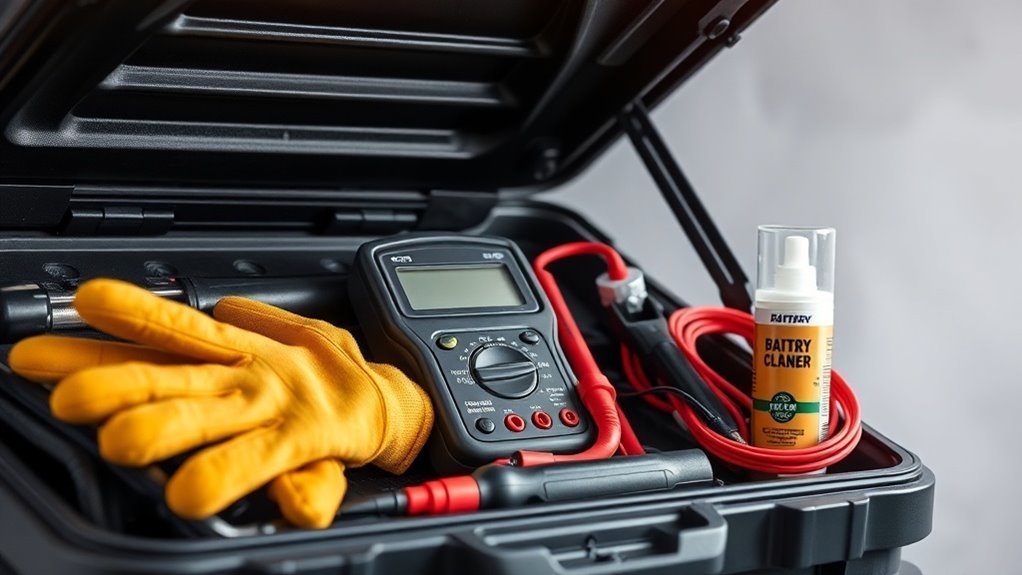How to Maintain and Clean Protective Equipment
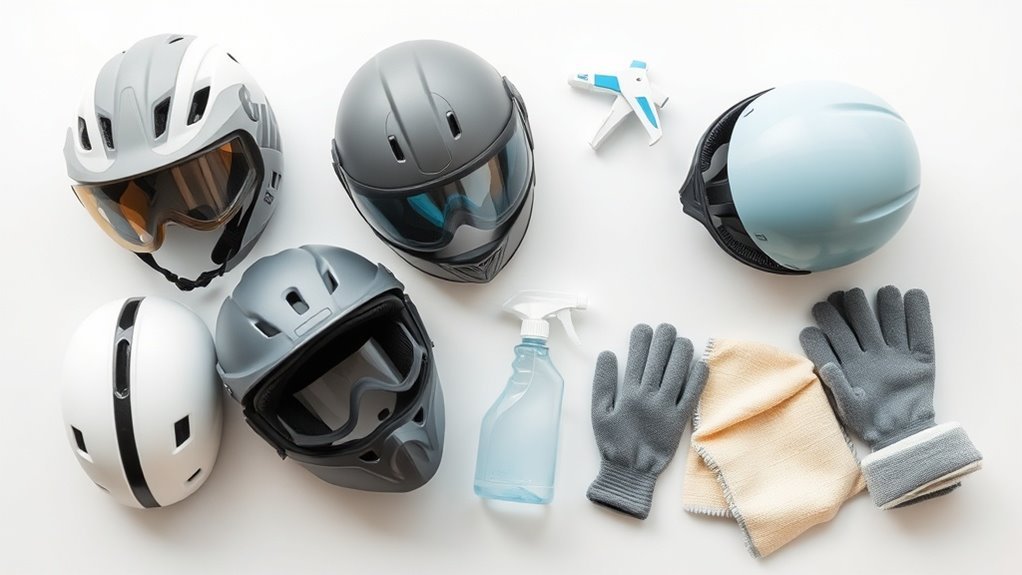
To maintain and clean your protective equipment, regularly inspect for damage and wear after each use. Use mild soaps and gentle cleaning supplies to guarantee longevity, and make sure all items are completely dry before storing. Keep your gear in a cool, dry place away from direct sunlight to prevent mold and deterioration. Don’t forget to establish a maintenance schedule for checking and cleaning items. There’s plenty more you can do to enhance your gear’s performance.
Key Takeaways
- Regularly inspect protective gear for damage, focusing on vulnerable areas like straps, buckles, and seams to ensure safety and functionality.
- Clean equipment with mild soaps or detergents, ensuring thorough drying to prevent mold and mildew growth before storage.
- Store gear in a cool, dry place using breathable bags to minimize moisture build-up and odor retention.
- Create a maintenance schedule for regular cleaning, inspections, and replacements tailored to the frequency of gear use.
- Replace any damaged or worn-out protective equipment promptly to ensure continued safety and effectiveness during use.
Importance of Maintaining Protective Equipment
Maintaining protective equipment is essential, especially since it can mean the difference between safety and serious injury. When you take care of your gear, you’re ensuring it functions correctly when you need it most.
Worn-out or damaged equipment can fail at critical moments, exposing you to unexpected hazards. Regularly checking for signs of wear and tear can help you catch issues early, preventing accidents down the line. Additionally, properly maintained gear can save you money in the long run by prolonging its lifespan. Always follow manufacturer guidelines for upkeep, and don’t overlook the importance of cleanliness—dirt and grime can compromise the integrity of your equipment. Staying proactive about maintenance keeps both you and your teammates safe on the job. Steel toe footwear, for example, plays a crucial role in protecting your feet from heavy objects and other potential dangers.
General Cleaning Guidelines
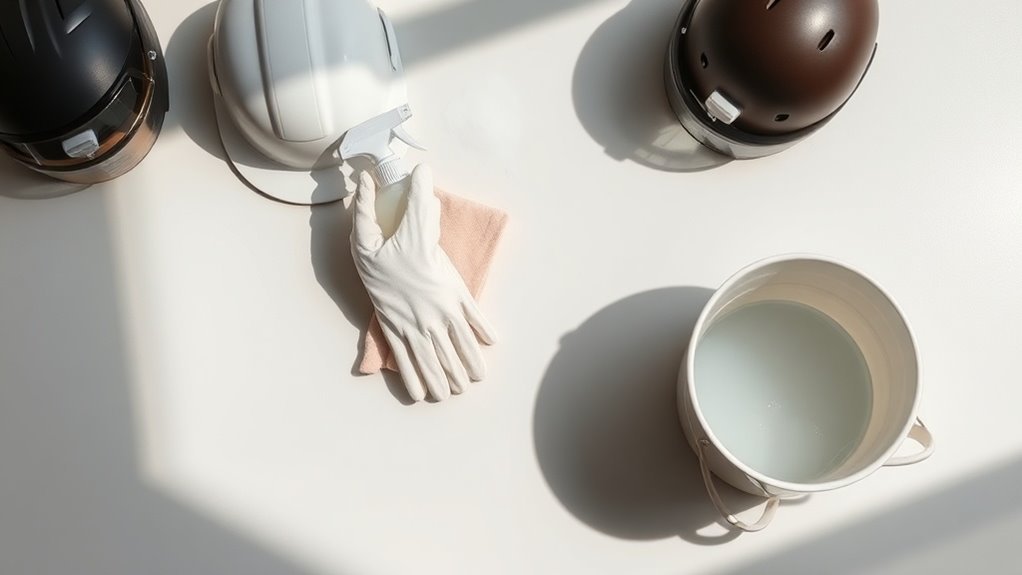
When it comes to keeping your protective equipment in top shape, having the right cleaning supplies is crucial. Establishing a regular maintenance routine guarantees that your gear lasts longer and performs better. Additionally, make sure to inspect your equipment for any signs of damage to ensure optimal safety and performance. Let’s look at the basics you need to get started.
Basic Cleaning Supplies
Keeping your protective equipment in top shape requires the right cleaning supplies.
Using quality products not only guarantees your gear lasts longer but also keeps you safe and comfortable. Here’s a basic list of supplies you’ll want to have on hand:
- Mild soap or detergent: Gentle yet effective for removing dirt.
- Soft cloths: Perfect for wiping surfaces without scratching.
- Brushes: For getting into nooks and crannies, guaranteeing thorough cleaning.
- Disinfectant: Essential for killing germs and bacteria after use.
- Water: The most basic and crucial ingredient for cleaning!
Investing in the right supplies makes a significant difference in how your equipment performs and feels.
You’ll be glad you did when it keeps you safe and ready for action!
Regular Maintenance Routine
While protective equipment is designed to withstand tough conditions, a regular maintenance routine is essential to guarantee it serves you well over time.
First, inspect your gear after each use for any damage, like cracks or tears. Clean your equipment using mild soap and water, ensuring all dirt and grime are removed. Use a soft brush for crevices and avoid harsh chemicals that can degrade materials.
After washing, let everything air dry completely before storing. Store your gear in a cool, dry place to prevent mold and mildew growth.
Finally, check manufacturer guidelines for specific maintenance instructions, and keep a log of any repairs or services performed. A bit of diligence now will extend the life of your protective gear markedly.
Care and Maintenance for Helmets
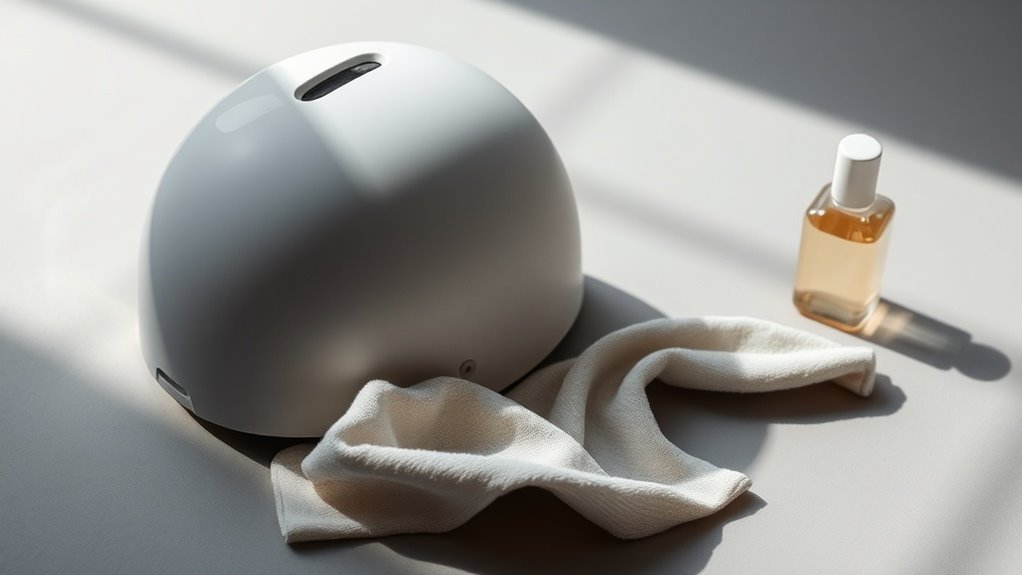
Although you might think that a helmet only needs to be replaced after an impact, regular care and maintenance are essential to assure its longevity and effectiveness.
Neglecting your helmet can put your safety at risk. By incorporating simple practices into your routine, you can guarantee you’re protected every time you ride.
- Make sure the fit is snug but comfortable, guaranteeing it stays in place.
- Inspect the exterior for cracks or damage regularly.
- Replace the internal foam padding as needed for comfort.
- Store it in a cool, dry place to avoid deformities.
- Clean the inner lining to prevent odor and bacteria growth.
Understanding safety gear standards is crucial for ensuring that your helmet meets specific safety certifications, which helps confirm its effectiveness in protecting your head.
Taking these steps helps maintain your helmet and protects your head where it matters most.
Proper Cleaning Techniques for Gloves
When it comes to keeping your gloves in top shape, choosing the right cleaning solutions is essential. You’ll also want to pay attention to how you dry and store them to avoid damage. Let’s go over some effective techniques to guarantee your gloves last as long as possible. Additionally, understanding the unique benefits of different materials can help you select gloves that are easier to clean and maintain.
Choosing Appropriate Cleaning Solutions
Choosing the right cleaning solutions for your gloves is essential, as improper care can compromise their protective qualities. You wouldn’t want to put yourself at risk by using harsh chemicals that could damage them.
Look for gentle, pH-balanced soaps or specialized glove cleaners designed for your glove material.
Here are some tips to guide you in selecting the right product:
- Preserve the integrity of your gloves
- Guarantee maximum protection against hazards
- Avoid skin irritation or allergic reactions
- Maintain comfort during extended use
- Extend the lifespan of your gloves
Drying and Storage Tips
After selecting the right cleaning solutions for your gloves, it’s important to focus on how you dry and store them properly.
To dry your gloves, avoid direct heat sources like radiators or hair dryers, as they can damage the material. Instead, air dry them in a well-ventilated area. Turn them inside out to guarantee they dry thoroughly, and never leave them crumpled up.
For storage, keep your gloves in a clean, dry place away from direct sunlight. Consider using a breathable bag to prevent moisture build-up. Avoid folding or crushing them, as this can cause them to lose shape.
Safeguarding Goggles and Face Shields
Safeguarding goggles and face shields is essential for guaranteeing your eyes and face remain protected during various tasks.
Proper maintenance and cleaning not only enhance visibility but also help prolong the life of these important items. Here are some tips to keep them in top shape:
- Regular Cleaning: Confirm lenses are free from dust and debris.
- Store Properly: Keep them in a safe, dry place, away from extremes.
- Avoid Scratches: Use soft cloths to clean them, preventing damage.
- Use Anti-Fog Spray: Enhances visibility and comfort during use.
- Check Fit Often: A secure fit is critical for protection during any task.
Additionally, wearing appropriate personal protective equipment ensures you reduce the risk of injuries while working on vehicles.
Inspecting Equipment for Damage
While you’re focused on your tasks, it’s crucial to regularly inspect your protective equipment for any signs of damage.
Start by examining each piece for cracks, dents, or other wear. Pay close attention to straps, buckles, and seams, as these are vulnerable areas that can compromise safety. If you notice any fraying or weakening, it’s time to retire that piece.
Examine your protective gear for cracks and wear, focusing on vulnerable straps and seams to ensure safety.
Don’t forget to check for proper functionality—ensure that any hinges or adjustments are working smoothly. Even minor issues can escalate, so it’s better to address them early.
Additionally, keep an eye out for any foreign substances that may have accumulated, as this could affect performance. Regular inspections will help you stay safe and prolong the life of your gear. Proper respiratory protection is essential to guard against the harmful effects of dust and fumes during your DIY projects.
Storing Protective Gear Correctly
Properly storing your protective gear is essential to ensuring its longevity and effectiveness.
When you take the extra time to do this, you’re prioritizing your safety and performance.
Here are some tips to keep in mind:
- Dry your gear completely to prevent mold and mildew.
- Store in a cool, dry place, away from direct sunlight to avoid material degradation.
- Use breathable bags for storage; this keeps gear ventilated and reduces odors.
- Keep items organized so you can easily find what you need right when you need it.
- Check regularly for damage during storage; you wouldn’t want to discover issues when it’s too late.
Protect your investment by storing your gear with care!
Creating a Maintenance Schedule
A well-planned maintenance schedule can make all the difference in extending the life of your protective equipment. Start by evaluating the specific needs of each item. Create a timeline for cleaning, inspections, and replacements.
A strategic maintenance schedule is essential for prolonging the lifespan of your protective gear. Assess each item’s needs and plan accordingly.
For instance, if you use your equipment regularly, plan for weekly checks and deep cleans monthly. Mark these tasks on a calendar or set reminders on your phone to stay on track.
Don’t forget to include a date for equipment replacement after a certain number of uses. This proactive approach not only guarantees your gear is safe but also enhances its performance.
Finally, make notes on any issues you encounter during checks to address them promptly, keeping your equipment in top shape for its next use.
Questions
How Often Should I Replace My Protective Equipment?
You should replace your protective equipment at least every three to five years or sooner if you notice wear and tear. Regular inspections help guarantee you’re safe and protected while doing your activities. Stay cautious!
Can I Use Bleach to Clean My Gear?
Using bleach on your gear could be like throwing a grenade into your safety setup! It’s too harsh and can damage materials. Stick with mild soaps and warm water for effective cleaning without ruining your equipment.
What Should I Do for Stubborn Stains?
For stubborn stains, try pre-treating with a stain remover or a mixture of baking soda and water. Apply it, let it sit for a bit, then wash as usual. Repeat if needed for tough marks.
Is It Safe to Machine Wash My Gloves?
Machine washing your gloves can be a slippery slope; it might damage them. Instead, hand washing’s gentle touch often guarantees their longevity, preserving both function and form, while keeping them ready for your next adventure.
How Can I Tell if My Equipment Is Too Worn to Use?
You can tell your equipment’s too worn by checking for visible damage, reduced effectiveness, or compromised fit. If you notice frayed materials, cracks, or discomfort, it’s time to replace them for safety reasons.
Conclusion
So, now that you know how to maintain and clean your protective equipment, you’ve got no excuse to treat it like last week’s leftovers! Remember, it’s not just about looking cool—those helmets and gloves aren’t fashion accessories! Neglecting them could turn that “superhero” moment into a comedy of errors. So, keep ‘em clean, check for damage, and store them like the precious gems they are. Trust us, your future self will thank you—preferably without a bandage!


